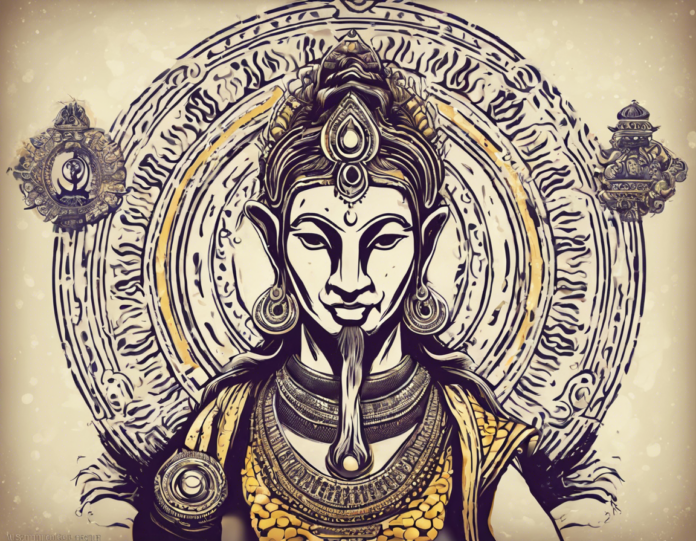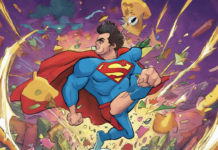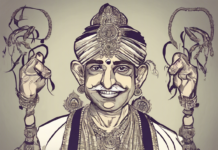Avatars of Vishnu: An Introduction
In Hindu mythology, Lord Vishnu is considered the preserver and protector of the universe. One of the key aspects of Vishnu’s role is his incarnations or avatars, which are believed to descend to Earth to restore cosmic order and righteousness. The ten avatars of Vishnu, known as the Dashavatara, represent different aspects of his supreme being and are widely revered in Hindu culture and philosophy. Each avatar has a specific purpose and symbolism that teaches important lessons and values to humanity. Let us delve into the mystical world of the ten avatars of Vishnu and unravel the significance behind each manifestation.
1. Matsya Avatar – The Fish Incarnation
The Matsya Avatar of Vishnu is the first incarnation and is depicted as a fish. According to Hindu scripture, Matsya saved the sages and the earth from a great flood by rescuing them in a massive boat. This avatar symbolizes the concept of preservation and protection, as well as the importance of environmental conservation and harmony with nature.
2. Kurma Avatar – The Tortoise Incarnation
The Kurma Avatar of Vishnu takes the form of a giant tortoise and is associated with the churning of the ocean of milk to obtain the elixir of life. This avatar represents stability, support, and the eternal nature of existence. It teaches us the virtues of patience, perseverance, and cooperation in overcoming challenges.
3. Varaha Avatar – The Boar Incarnation
In the Varaha Avatar, Vishnu incarnates as a boar to rescue the earth goddess, Bhudevi, from the demon Hiranyaksha who had submerged her in the cosmic ocean. This avatar symbolizes the triumph of good over evil and the importance of upholding righteousness and justice in the face of adversity.
4. Narasimha Avatar – The Man-Lion Incarnation
The Narasimha Avatar of Vishnu represents a half-man, half-lion form that emerged to protect his devotee Prahlada from the tyranny of the demon king Hiranyakashipu. This avatar embodies the concept of divine wrath against injustice and the assurance that righteousness will always prevail over evil.
5. Vamana Avatar – The Dwarf Incarnation
Vishnu’s Vamana Avatar appears as a dwarf Brahmin who seeks land from the demon king Bali. With three steps, Vamana covers the entire universe, teaching Bali humility and the importance of not being attached to material possessions. This avatar symbolizes the values of humility, righteousness, and balance in life.
6. Parashurama Avatar – The Warrior Incarnation
Parashurama is the sixth avatar of Vishnu and is depicted as a fierce warrior wielding an axe. He appears to rid the world of corrupt and arrogant rulers, restoring balance and order. This avatar signifies the importance of upholding Dharma (righteousness) and standing up against oppression and injustice.
7. Rama Avatar – The Prince of Ayodhya
The seventh avatar of Vishnu is Lord Rama, the iconic prince and king of Ayodhya. Rama is revered for his adherence to duty, honor, and integrity while facing numerous challenges during his exile and quest to rescue his wife Sita from the demon king Ravana. The Rama Avatar teaches the virtues of loyalty, righteousness, and sacrifice in fulfilling one’s responsibilities.
8. Krishna Avatar – The Cowherd Prince
Lord Krishna is the eighth avatar of Vishnu and is considered one of the most beloved and revered deities in Hinduism. Known for his teachings in the Bhagavad Gita and his playful exploits in Vrindavan, Krishna embodies love, compassion, and divine wisdom. The Krishna Avatar symbolizes the supreme consciousness and the path to spiritual enlightenment through devotion and selfless action.
9. Buddha Avatar – The Enlightened One
In some traditions, Lord Buddha is considered an avatar of Vishnu who appeared to teach the path of enlightenment and compassion to humanity. Buddha’s teachings on the Four Noble Truths and the Eightfold Path emphasize the importance of overcoming suffering and attaining inner peace through mindfulness and self-awareness. This avatar signifies the transcendence of worldly illusions and the pursuit of spiritual liberation.
10. Kalki Avatar – The Future Incarnation
The Kalki Avatar is believed to be the tenth and final incarnation of Vishnu, who is yet to appear at the end of the Kali Yuga (the current age of darkness and decay). Kalki is prophesied to arrive riding a white horse with a sword in hand to vanquish evil forces, restore righteousness, and inaugurate a new age of peace and harmony. This avatar symbolizes hope, renewal, and the eternal cycle of creation and destruction in the cosmic order.
Frequently Asked Questions (FAQs)
1. What is the significance of the ten avatars of Vishnu?
The ten avatars of Vishnu symbolize different aspects of cosmic order, righteousness, and the eternal cycle of creation and preservation. They teach important moral and spiritual lessons to humanity and illustrate the triumph of good over evil.
2. Are the avatars of Vishnu worshipped in Hinduism?
Yes, the avatars of Vishnu are widely worshipped in Hinduism through rituals, prayers, and festivals dedicated to each incarnation. Devotees seek blessings, guidance, and protection from Vishnu and his avatars in their daily lives.
3. How are the avatars of Vishnu related to the concept of Dharma?
The avatars of Vishnu uphold the principle of Dharma, which refers to righteousness, duty, and moral law. Each incarnation demonstrates the importance of standing up for Dharma, protecting the innocent, and maintaining balance and order in the universe.
4. What can we learn from the stories of Vishnu’s avatars?
The stories of Vishnu’s avatars teach valuable lessons such as courage, compassion, humility, devotion, and selflessness. They inspire individuals to follow the path of righteousness, overcome challenges, and strive for spiritual growth and enlightenment.
5. How do the avatars of Vishnu reflect the diversity of existence?
The avatars of Vishnu manifest in diverse forms such as animals, humans, and divine beings, representing the multifaceted nature of existence and the interconnectedness of all life forms. They symbolize the unity of the material and spiritual realms in the cosmic creation.
6. Are there other avatars of Vishnu apart from the Dashavatara?
In addition to the ten avatars of Vishnu, there are numerous other incarnations mentioned in various Hindu scriptures and folklore. These avatars serve specific purposes and play vital roles in maintaining cosmic balance and order.
7. How do the avatars of Vishnu inspire devotees in their spiritual journey?
Devotees of Vishnu draw inspiration from the avatars’ stories and teachings to deepen their spiritual practices, cultivate virtues, and overcome obstacles on the path to self-realization and inner peace. The avatars serve as guides and mentors in the devotees’ quest for enlightenment.
8. What is the role of Vishnu’s avatars in the cosmic creation cycle?
Vishnu’s avatars play a crucial role in the cosmic creation cycle by intervening in times of crisis, restoring balance and order, and ensuring the continuity of life and existence. They represent the eternal principles of preservation, transformation, and evolution in the universe.
9. How are the avatars of Vishnu depicted in art and mythology?
The avatars of Vishnu are depicted in various art forms such as sculpture, painting, dance, and drama, reflecting their divine attributes, symbolism, and significance. Mythological stories and scriptures describe the appearance, attributes, and exploits of each avatar in great detail.
10. Can devotees connect with Vishnu through meditation on his avatars?
Yes, devotees can connect with Vishnu through meditation, prayer, and contemplation on his avatars’ qualities, teachings, and virtues. By invoking the presence and blessings of the avatars, devotees can deepen their spiritual connection with Vishnu and seek guidance on their spiritual journey.









